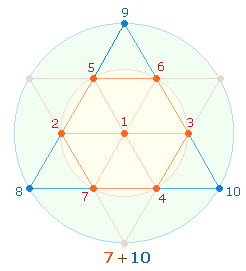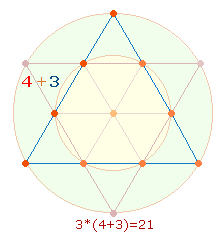Ovid's and Shakespeare's epitaphs
The factoral sum 971 in Shakespeare's
epitaph
1. The numerical sum (NS) of Shakespeare's epitaph is 1242, the factoral sum (FS)
971. Why did Shakespeare choose this unusual
prime number? The answer seems clear: because he needed it to adapt his results
to Ovid's epitaph. Although there might be a lucky coincidence, Shakespeare
knew very well about the meaning of 971.
2.
Perhaps Shakespeare hit upon 971
because it is a particular inversion, e.g. the NS
of OVIDIUS (94)
and Shakespeare (103)
is 197, but we do not know. The digit 1
mostly suggests the midpoint of a circle. Shakespeare had a predilection for
the hexagram because it contains two tetractyses consisting of 37 elements each and the NS
of WILLIAM is 74 = 2*37. So the digits may refer to 7
points of the hexagon, to 9 points of the
tetractys frame and the midpoint of the
tetractys:
|
|
3.
Of the 6 inversions
only 2 are no prime numbers:
|
nr. |
179 |
197 |
719 |
791 |
917 |
971 |
3774 |
|
FV |
179 |
197 |
719 |
120 |
138 |
971 |
2324 |
|
sm |
|
|
|
|
|
|
6098 |
|
2324 = 4*7*83
>FV 94 = 2*47 |
|||||||
We see
that 23+24 = 47 and 2324
is divisible by 4*7 = 28. 28 is the sum of the numbers 1-7.
The ratio of the basic inverted numbers 12:21
is 3*(4:7).
The single digits 2+3 and 2+4 represent the
double aspect of 5 diametric and 6 radial elements, 2
referring to the radial lines of the axis of a circle:
|
|
In
addition or principally, Shakespeare was motivated by the NS ratio 4:7 of MARIA (40) and IESUS (70).
The
numbers 7 and 4
especially refer to the NS 74 of Shakespeare's
first name WILLIAM. The FV of 74 is 39, which is 113
together and the number of letters of the epitaph. The inversion 791 is 7*113.
4.
The double aspect of diametric and radial elements can
also be represented by 8+3:
|
|
Likewise the 11 elements of the rhombus can be divided into 8+3:
|
|
With
reference to the hexagram, 83 is the sum of the numbers 1-7 = 28 and 1-10 = 55 of
the tetractys.
5.
The number 83 is the main factor of the 4value sum of the 28 words of the epitaph so that 83 is the average 4value
sum:
|
NS |
FS |
sm |
FV1 |
FV2 |
sm |
tot. |
|
1242 |
971 |
2213 |
560 |
547 |
1107 |
3320 |
|
3320 = 40*83 |
||||||
The
number 332 can be seen as a contraction of (3+3)+(3+2) with regard to the double aspect of
radial and diametric elements.
6.
The NS+FS of WILLIAM
is 74+52.
Three words of the epitaph have the same NS: ENCLOASED (74) SPARES (74) BONES (52). Their 4value sum is divisible by 83:
|
let. |
|
NS |
FS |
sm |
FV1 |
FV2 |
sm |
tot. |
|
9 |
ENCLOASED |
74 |
59 |
133 |
39 |
59 |
98 |
231 |
|
6 |
SPARES |
74 |
47 |
121 |
39 |
47 |
86 |
207 |
|
5 |
BONES |
52 |
37 |
89 |
17 |
37 |
54 |
143 |
|
20 |
|
200 |
143 |
343 |
95 |
143 |
238 |
581 |
|
581 = 7*83 |
||||||||
The sum 581 is the fourth part of FS
2324 of the six inversions.
7.
The factors of the two non-prime numbers are inversions: 791 = 7*113, 917
= 7*131. The difference of the
two numbers is 7*18 = 126, which is the NS+FS 74+52 of WILLIAM. The factoral sum of the two numbers is 258 = 2*3*43, which can be related to the frames
of two inverted tetractyses: 2*3*(4+3):
|
|
Written: June 2014




